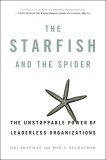Estimated reading time: 4 minute(s)
 I mentioned not long ago the extensive list of books I am currently reading. One of those was the book you see to the right. I’ve been focusing on that one lately, and it’s amazing how much what this fellow is saying about the business world (really, so far it’s just an observation of various historical events, including those in the business world) so closely mirrors what the church can (or should?) be.
I mentioned not long ago the extensive list of books I am currently reading. One of those was the book you see to the right. I’ve been focusing on that one lately, and it’s amazing how much what this fellow is saying about the business world (really, so far it’s just an observation of various historical events, including those in the business world) so closely mirrors what the church can (or should?) be.
The chapter I am currently reading is explaining the difference between a spider and a starfish. The spider is as we would expect it. A central head, that controls everything. If you lop off a leg or two, the spider will survive, but if you destroy the head, nothing else will survive. The starfish is different. Any part can survive on its own. “If you cut a starfish in half…” says the author, “you’ll have two starfish to deal with.” The starfish can “regenerate” from any part of its body since there is no central brain or other center of operations. The creature is a sort of neural network.
Instead of having a head, like a spider, the starfish functions as a decentralized network… The starfish doesn’t have a brain. There is no central command. Biologists are still scratching their heads over how the creature operates…”
Indeed, at first glance, that seems chaotic, but somehow in God’s design, this creature works just fine as a decentralized unit.
The first case study was all of the peer to peer music/file sharing businesses. The more decentralized they got, the better they “worked” and the harder they were to kill. Record companies could shut down Napster because everything was in one place under one business name. But as it continues to decentralize, it’s harder to stop… can thrive without a “head”.
And last night, I was reading about the found of Alcoholics Anonymous. Pretty neat how it started out. The guy who started it (an alcoholic) was at the very end of his rope, and figured the only folks who could help him were the people in the same boat as him. So he created a structure that had no leaders, or heirarchy. Just people helping people.
The organization functions just like a starfish. You automatically become part of the leadership-an arm of the starfish, if you will-the moment you join…
Because there is no one in charge, everyone is responsible for keeping themselves—and everyone else—on track. … You have a sponsor, but the sponsor doesn’t lead by coercion; that person leads by example. And if you mess up and relapse or stop attending for a while, you’re always welcome to come back.
(emphasis mine)
That seems so close to what I see being the best model of life as the church. The living body of Christ. We are all equal parts of the greater whole—Christ’s body. I’m not sure how his being the “Head” fits that picture, when thinking of starfish, but as the rest of his body… it’s right on. Everyone is responsible for themselves, and cares for each other. Because they are all “in it together”.
After AA took off and became a huge success, the author says:
Bill (the founder) had a crucial decision to make. He could go with the spider option and control what the chapters could and couldn’t do. Under this scenario, he’d have to manage the brand and train applicants in the AA methodology. Or, he could go with the starfish approach and get out of the way. He chose the latter. He let go.
He trusted each chapter to do what it thought was right. And so today, whether you’re in Ancorage, Alaska or Santiago, Chile you can find an AA meeting. And if you feel like it, you can start your own. Members have always been able to directly help each other without asking permission or getting approval from Bill W. or anyone else. This quality enables open systems to quickly adapt and respond.
(emphasis mine)
Christianity could certainly learn from this model. Instead of fighting to protect and preserve, a more open system would encourage the body of Christ to be “known by our love for one another”. Not our big buildings, flashy presentations, big events, wonderfully entertaining programs, etc, etc, etc. And, the body of Christ could function so much better if our only direction came from The Head (not the pretend “heads” we have set up). Rather than chaos, wouldn’t it be much more perfect, and more quick to respond.
See, Jesus is a weird head. The starfish can regenerate and fix itself because the head is located everywhere. The brain is in every cell of the body (I guess?). Isn’t that kind of like Jesus. He’s not in a fixed location, in the Home Office at 1 Golden Street Drive. He’s here, with me right now, as much as he is with you. (“I will be with you always…”) So, he can quickly help me know that I need to go over and see my neighbor… and I might find out that she needs help with something… or maybe she’s just feeling down. Or maybe even, she has some good news she needs to share with someone? As the head of a body that has no heirarchichal leadership, he can quickly move and “regenerate” his body as he needs to. No waiting for staff or deacons meetings. 🙂
I’m enjoying the book. I’m sure I’ll post more here later. Just wanted to share a couple of quotes that stood out to me last night.

I think you might want to think of Jesus as a head in two ways:
1) the only way that the starfish can replicate in the way it does is because the instructions for doing so are woven throughout the DNA of the organism; there are still microscopic processes like RNA synthesis, cell replication, etc. that are founded into the DNA, but it’s just at a much smaller level.
2) Jesus created the starfish. Enough said.
Another couple books related to this topic you might find appealing (and I strongly recommend you read): “Organic Church” by Neil Cole, and “The Forgotten Ways” by Alan Hirsch. Al mentioned once that he cites the Starfish book in his text (I’m not all the way done with it yet).